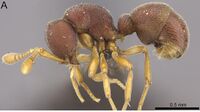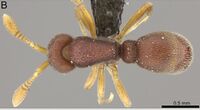Discothyrea aisnetu
| Discothyrea aisnetu | |
|---|---|

| |
| Scientific classification | |
| Kingdom: | Animalia |
| Phylum: | Arthropoda |
| Class: | Insecta |
| Order: | Hymenoptera |
| Family: | Formicidae |
| Subfamily: | Proceratiinae |
| Tribe: | Proceratiini |
| Genus: | Discothyrea |
| Species group: | traegaordhi |
| Species: | D. aisnetu |
| Binomial name | |
| Discothyrea aisnetu Hita-Garcia & Lieberman, 2019 | |
At present Discothyrea aisnetu is known only from the type locality, the Kindoroko Forest Reserve in Tanzania, which is a montane rainforest located at an altitude of 1739 m. It was sampled from leaf litter.
Identification
Hita-Garcia and Lieberman (2019) - The following character combination separates D. aisnetu from the other members of the Discothyrea traegaordhi species complex:
- mesosomal profile high-rounded and extremely convex
- relatively large species (HW 0.57–0.61; WL 0.80–0.90)
- in dorsal view mesosoma relatively thin and slender (DMI 53–58; DMI2 85–88)
- mesotibia without apicoventral spur
- AT3 around 1.1 to 1.2 times longer than AT4 (ASI 85–90)
This highly characteristic species displays a unique mesosomal shape not seen in the remainder of the African Discothyrea fauna. Within the traegaordhi-complex it is a rather large species with long limbs, comparatively distinct flagellomeres and relatively narrow apical club. This is a character set shared only with Discothyrea poweri. However, it remains unclear if these two species are closely related since apart from the differently shaped mesosomal outline, D. aisnetu also lacks the mesotibial spur present in D. poweri, which is an important diagnostic character.
Discothyrea aisnetu varies slightly in color and in the pattern of punctae on the lateral pronotum just anterad the pronotomesepisternal juncture: they are more or less arranged in concentric broken lines.
Keys including this Species
Distribution
Latitudinal Distribution Pattern
Latitudinal Range: -3.7452° to -3.7452°.
| North Temperate |
North Subtropical |
Tropical | South Subtropical |
South Temperate |
- Source: AntMaps
Distribution based on Regional Taxon Lists
Afrotropical Region: United Republic of Tanzania.
Distribution based on AntMaps
Distribution based on AntWeb specimens
Check data from AntWeb
Countries Occupied
| Number of countries occupied by this species based on AntWiki Regional Taxon Lists. In general, fewer countries occupied indicates a narrower range, while more countries indicates a more widespread species. |

|
Estimated Abundance
| Relative abundance based on number of AntMaps records per species (this species within the purple bar). Fewer records (to the left) indicates a less abundant/encountered species while more records (to the right) indicates more abundant/encountered species. |

|
Biology
Castes
 X-ray micro-CT scan 3D model of Discothyrea aisnetu (worker) prepared by the Economo lab at OIST.
X-ray micro-CT scan 3D model of Discothyrea aisnetu (worker) prepared by the Economo lab at OIST.
See on Sketchfab. See list of 3D images.
Nomenclature
The following information is derived from Barry Bolton's Online Catalogue of the Ants of the World.
- aisnetu. Discothyrea aisnetu Hita Garcia & Lieberman, in Hita Garcia, Lieberman, et al. 2019: 29, figs. 4C, 6C-12C, 14C, 23, 24 (w.) TANZANIA.
- Type-material: holotype worker, 2 paratype workers.
- Type-locality: holotype Tanzania: Kilimanjaro Region, Mwanga, Kindoroko Forest Reserve, -3.7452, 37.64267, 1739 m., CEPF-TZ-5.2, 5-8.ix.2005, primary forest, leaf litter, Winkler (P. Hawkes, J. Makwati & R. Mtana); paratypes: 1 worker with same data, 1 worker with same data but CEPF-TZ-5.4, hand collected.
- Type-depositories: SAMC (holotype); BMNH, CASC (paratypes).
- Distribution: Tanzania.
Unless otherwise noted the text for the remainder of this section is reported from the publication that includes the original description.
Description
Worker
(n = 3) EL 0.03; HL 0.68–0.70; HW 0.57–0.61; SL 0.43–0.45; PH 0.40–0.43; PW 0.46–0.48; DML 0.52–0.57; PrH 0.49–0.53; WL 0.80–0.90; HFL 0.55–0.58; PeL 0.15–0.17; PeW 0.33–0.37; PeH 0.30–0.31; LT3 0.50–0.56; LT4 0.45–0.50; OI 4; CI 84–87; SI 63–67; LMI 44–51; DMI 53–58; DMI2 85–88; ASI 85–90; HFI 64–69; DPeI 218–220; LPeI 184–200.
Head slightly longer than broad (CI 84–87), posterior head margin nearly straight; posterodorsal corners of head rounded; sides of head slightly constricted laterally between eyes and anterolateral corner of gena, this region appearing concave in frontal view; eyes present, small (OI 4), round, comprising several ommatidia, situated around one-third of way between corner of gena and posterior head margin; eyes just visible in frontal view; frontal lamella triangular in profile, apex rounded; lamella more or less evenly translucent across its disc, without fenestra; medial clypeus broad, gently convex, lateral clypeus curving gently between antennal sockets and anterolateral corners of head, bearing short, dense, curved setae. Antenna with long scape (SI 63–67), scape somewhat expanded apically, gently bent; pedicel campaniform, longer than broad; true antennomere count nine; apparent antennomere count nine to eleven, flagellomeres basad apical club relatively long, taken together longer than apical club; club relatively narrow. Ventral head with postoccipital ridge well-defined, with very short anteromedian carina; hypostoma very wide overall, median region bluntly triangular, arms only slightly narrowed, similar in width across their entire length; palpal formula not examined. Mandible edentate; basal angle rounded; ectal face with low carina originating near basal angle and becoming confluent with masticatory margin at apical one-fourth, leaving narrow, arcuate, depressed medial region on masticatory margin.
Mesosoma in profile robust, high-rounded and extremely convex; in dorsal view mesosoma relatively thin and slender (DMI 53–58; DMI2 85–88) and distinctly narrowed posteriorly, pronotum significantly wider than propodeum; pronotal humeri broadly rounded; posterior propodeal margin indistinct or appearing straight; in profile, propodeum without distinct juncture between dorsal and declivitous faces, lacking angles or denticles, not marginate; propodeal declivity sloping, at most barely concave in oblique posterior view; propodeal spiracle distinct, aperture round, directed posteriorly; propodeal lobes well-developed, flange-like.
Legs moderately long to long and narrow (HFI 64–69); mesotibia without apicoventral spur, with small but distinct seta inserted in apical pit; mesobasitarsus very elongate, almost as long as remaining tarsomeres taken together.
Petiole node quite thick, about 1.8 to 2.0 times higher than long (LPeI 184–200), rounded-cuneate in profile; in profile anterior face of node sloping posterodorsally, gently curved, apex rounded, hence without distinct posterior face; in dorsal view, node rounded-rectangular to nearly elliptical, around 2.2 times broader than long (DPeI 218–220), sides convex; in anterior view, petiolar outline broadly disciform, without distinct angles, dorsally rounded; in ventral view, sides distinctly curved, outline campaniform; subpetiolar process elongate-triangular, weakly spiniform to digitate, anteriorly projecting, apex approximately rounded; petiolar spiracles very large, round in ventral view.
Abdominal segment 3 campaniform, widest posteriorly, sternite rounded and distinctly bulging in profile; AS3 with weak medial carina; prora present as a fine carina, weakly concave in ventral view; AT3 around 1.1 to 1.2 times longer than AT4 (ASI 85–90); AT4 gently recurved hemidemispherical; AS4 with anterior lip short and narrow, scarcely overlapping AS3, anterior margin straight in ventral view; successive abdominal segments short, telescopic, often concealed.
Sculpture on head evenly punctate-reticulate, sculpture equally developed over head except medial clypeus distinctly smoother; mandibles fairly smooth but with fine piligerous punctulae; mesosoma similarly punctate-reticulate on dorsum and sides, punctae sometimes arranged in concentric lines just anterad pronotomesepisternal junction; declivitious face of propodeum finely reticulate to confused-rugulose; petiole and abdominal segment 3 (tergite and sternite) similarly punctate-reticulate, punctures on AT3 piligerous; abdominal tergite 4 distinctively shinier and less coarsely sculptured than AT3 with fine piligerous punctulae and posteriorly with a few scattered, shallow punctae.
Setation on head and scape fairly short, dense, appressed and white pubescence; ectal face of mandible with fairly long, thin, curved, spaced setae; masticatory margin with row of straight, stout setae; mesosoma with well-developed appressed pubescence, more abundant on dorsum and lateral pronotum than remainder of mesosoma, shortest and most diffuse on sides of propodeum; petiole heavily setose, setae appressed to decumbent, quite long and thick, especially on dorsum of node; setae obscuring petiolar sculpture; ventral margin of petiolar sternite with row of straight, erect hairs; abdominal segment 3 with fairly long, mostly appressed setae, similar on tergite and sternite; AT4 more heavily setose; dorsum most strongly pubescent, becoming more diffuse ventrolaterad; successive abdominal segments with long, flexuous, curved pilosity; legs with appressed, fine pubescence, on tibiae and tarsi generally longer than on femora.
Color luteous-orange to deep iron-red, appendages yellow
Type Material
See the beginning of this ("Nomenclature") section for detailed information about the specimen types. A cyber-type of the holotype is also available. This includes: Volumetric raw data (in DICOM format), 3D rotation video, still images of surface volume rendering, and 3D surface (in PLY format) of the physical holotype (The Natural History Museum: CASENT0250399);) in addition to stacked digital color images illustrating the head in full-face view, plus profile and dorsal views of the body. The data are deposited at Dryad and can be freely accessed as virtual representation of the type. There is also a Sketchfab 3D surface model of the holotype. It is shown above, in the Caste section, and at Sketchfab (see the link in the Caste Section).
Etymology
The specific epithet is the Latin interjection ‘Aisne tu?’ meaning roughly ‘Could it be?’ (lit. ‘Do you say?’), recalling the authors’ reactions upon first viewing this aberrant species
References
- Hita-Garcia, F., Lieberman, Z., Audisio, T.L., Liu, C., Economo, E.P. 2019. Revision of the highly specialized ant genus Discothyrea (Hymenoptera: Formicidae) in the Afrotropics with x-ray microtomography and 3D cybertaxonomy. Insect Systematics and Diversity. 3(6): 5; 1–84 (doi:10.1093/isd/ixz015).
References based on Global Ant Biodiversity Informatics
- Hita-Garcia F., Z. Lieberman, T. L. Audisio, C. Liu, and E. P. Economo. 2019. Revision of the highly specialized ant genus Discothyrea (Hymenoptera: Formicidae) in the Afrotropics with X-ray microtomography and 3D cybertaxonomy. Insect Systematics and Diversity 3(6): 5:1-84.

